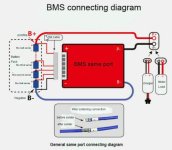docw009
1 MW
So we know it's a 13S BMS, and it looks like a 52 cell 13S pack.
Don't be using a 14S charger on a 13S pack. You can get away with it if you have a working BMS but it is quite risky. At this stage in your learning curve, don't be using it.
You should also check all 13 series groups for voltage to make sure all in useable spec.Nothing over 4.2V or below 2.7V (I know 2.5 is minimum),
I am with Flippy and Chalo. That BMS ain't working if all of the red wires aren't connected. It's designed to shut off continuity between P- and B- if any of the series voltages are below 2.5V. It will shut off continuity between C- and B- if any of the series voltages exceed 4.2V. Per this spec it doesn''t balance.
https://www.aliexpress.com/item/Waterproof-14S-48V-25A-35A-45A-60A-Electric-Vehicle-Lithium-Battery-Protection-Board-BMS-with-Balance/32842587387.html?src=google&albslr=230310488&src=google&albch=shopping&acnt=494-037-6276&isdl=y&slnk=&plac=&mtctp=&albbt=Google_7_shopping&aff_platform=google&aff_short_key=UneMJZVf&&albagn=888888&albcp=1582410664&albag=59754279756&trgt=296904914040&crea=en32842587387&netw=u&device=c&gclid=Cj0KCQjwwODlBRDuARIsAMy_28V_RSAY1AHC0hriqDxqYMSstwrhDvKUA8WBorw7fjQ7g2ey5EHdgAcaArsUEALw_wcB&gclsrc=aw.ds
Sorry. Even though it's waterproof, if it can't balance, it's not the unit you want to use with a pack that is made up of used cells.
Don't be using a 14S charger on a 13S pack. You can get away with it if you have a working BMS but it is quite risky. At this stage in your learning curve, don't be using it.
You should also check all 13 series groups for voltage to make sure all in useable spec.Nothing over 4.2V or below 2.7V (I know 2.5 is minimum),
I am with Flippy and Chalo. That BMS ain't working if all of the red wires aren't connected. It's designed to shut off continuity between P- and B- if any of the series voltages are below 2.5V. It will shut off continuity between C- and B- if any of the series voltages exceed 4.2V. Per this spec it doesn''t balance.
https://www.aliexpress.com/item/Waterproof-14S-48V-25A-35A-45A-60A-Electric-Vehicle-Lithium-Battery-Protection-Board-BMS-with-Balance/32842587387.html?src=google&albslr=230310488&src=google&albch=shopping&acnt=494-037-6276&isdl=y&slnk=&plac=&mtctp=&albbt=Google_7_shopping&aff_platform=google&aff_short_key=UneMJZVf&&albagn=888888&albcp=1582410664&albag=59754279756&trgt=296904914040&crea=en32842587387&netw=u&device=c&gclid=Cj0KCQjwwODlBRDuARIsAMy_28V_RSAY1AHC0hriqDxqYMSstwrhDvKUA8WBorw7fjQ7g2ey5EHdgAcaArsUEALw_wcB&gclsrc=aw.ds
Sorry. Even though it's waterproof, if it can't balance, it's not the unit you want to use with a pack that is made up of used cells.


